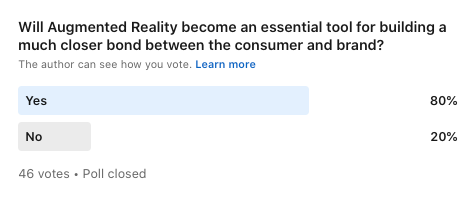
Article posted by
Without realising it, you have probably experienced Augmented Reality (AR) already. Not to be confused with Virtual Reality (VR) where a headset can transport you into a wholly virtual world, AR often requires nothing more than a smartphone, where digital layers are added to a real-world view. If you’ve ever put rabbit ears or a clown hat filter onto a selfie on Zoom, Snapchat, or Instagram, you’ve used AR. You might also have seen TV weather reports where the presenter is pictured in the eye of a storm or knee deep in flood water and not realised that was AR. And back in 2016, that Pokemon Go craze was all AR.
Augmented reality is more ubiquitous than you might think. The market is already worth $15bn and is predicted to grow to $70bn-$75bn in revenue by 2023, with three times as many active AR devices in use by then. Tech research firm Forrester predicts that almost half of all online consumers in the US will have experienced AR by the end of this year, such is the activity in the space. It has already surpassed computer-generated visuals as a novelty, moving into auditory, haptic, and olfactory enhancements, and as such, is primed for adoption in countless industry sectors.
In medicine and healthcare, for example, students can practice surgical techniques more realistically, and it has the potential to transform images from MRI and CT scans, as well as replace invasive cameras and probes in procedures. In the travel sector, Gatwick Airport has won awards for its smartphone app that helps passengers navigate through the terminals to their departure gates. The education, leisure and automotive industries are all in their early stages of unlocking the advantages of AR, but one of the most interesting areas of development are the possibilities for the retail and consumer sector.
The global COVID-19 pandemic has been a game-changer for retail. The shift from bricks-and-mortar to e-commerce that was already underway was even bigger in 2020, paving the way for AR to come into its own and replace the physical in-store customer experience (CX). An integral part of CX philosophy is storytelling, and AR enables brands to do this in many innovative ways. Many of our own clients are already mapping out forward-thinking plans to take advantage of the technology. The virtual fitting room, for example, is proving to be a popular tool with consumers. Brands such as Gucci, Estée Lauder, Pandora and L'Oréal are all offering customers the ability to see how clothing, cosmetics, glasses and jewellery look virtually tried on. Try before you buy, without going into a store, is efficient, convenient, and most probably here to stay. Ted Baker has taken things a step further with live fashion events where customers can ask questions about an item and virtually browse through the racks to try on. The potential for in-depth product launches and live information hugely improves upon a physical in-store visit and adding in the ability to contact customers later with updates via wearable devices, means a personalised shopping experience could soon be the norm for us all.
Our own research shows that AR will become an essential tool for developing the crucial bond between the consumer and the brand. A recent LinkedIn survey we conducted showed 80% agree.

On the consumer side, a recent survey by a third party showed that 71% of shoppers said that they would shop more often if they could use AR, while 40% would even consider paying more if they could examine a product in more detail with AR before purchasing. These figures are interesting in that they are not showing the typical hesitancy or adoption reluctance that new technology often suffers from. Whether that is because of the enforced changes the past year has delivered, the innate user-friendliness of AR, or a combination of all of these things, all signs point to AR being the potential saviour of a struggling retail sector.



